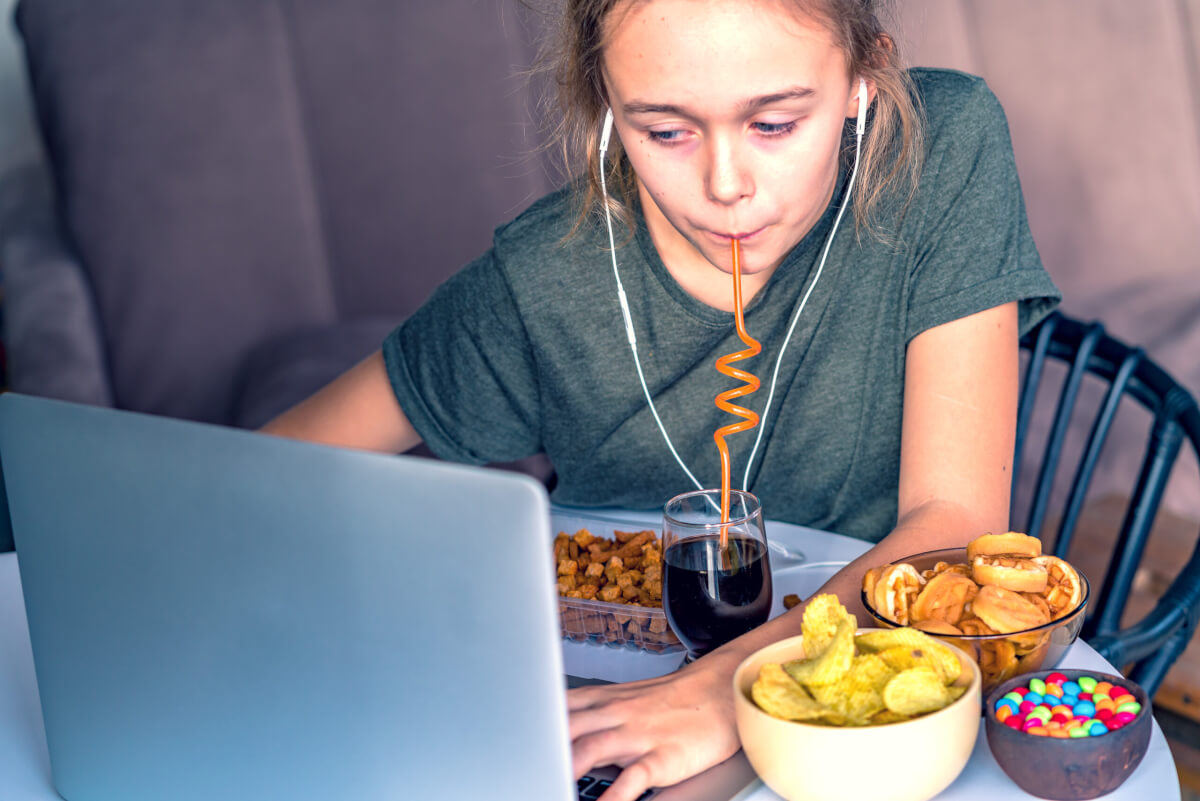
(© Juliaap - stock.adobe.com)
LIVERPOOL, United Kingdom — Nowadays, it seems like kids and teens are more likely to have a favorite streamer than a favorite TV show. They get a lot of their entertainment from creators on video game livestreaming platforms (VGLSPs) like Twitch, but those also contain advertisements, too. According to new research, unhealthy food and drink ads on VGLSPs are linked to kids eating and having more positive attitudes about unhealthy foods.
VGLSPs have been rapidly growing in popularity in recent years, competing with platforms like YouTube and inspiring new platforms like Kick to surface. These platforms are most utilized by users who want to watch streamed video game content with a live chat feature. Not everyone streams video games, though; some do commentary, cooking, art, or more.
At the time of this research published in the journal Appetite, the top VGLSPs around the world were Twitch (with 77% of the market share by hours watched), YouTube Gaming (15%), and Facebook Gaming Live (7%). Kick, which recently launched in 2022, has now taken over the third-place spot. In 2023 alone, there were almost 30 billion hours of content viewed on the top three platforms. Due to the popularity of these platforms among today's youth, brands have seen it as a shiny new way to market. Specifically, food and drink brands can effectively engage with teens.
“Endorsement deals for prominent streamers on Twitch can be worth many millions of dollars, and younger people, who are attractive to advertisers, are moving away from television to these more interactive forms of entertainment. These deals involve collaborating with brands and promoting their products, including foods that are high in fats, salt and/or sugar,” explains Dr. Rebecca Evans from the University of Liverpool in a media release.

Dr. Evans and her University of Liverpool colleagues examined the extent and nature of food marketing on VGLSPs and how this affects teenage eating patterns. They conducted a content analysis to examine the extent and nature of food cues displayed in 52 Twitch videos (52 hours of video content) uploaded from October 2020 to September 2021 by three influencers popular among adolescents. They then systematically reviewed the evidence for a link between exposure to digital game-based (e.g., in-game advertising, advergames) or influencer food marketing (two key techniques used on VGLSPs) and food-related outcomes such as attitudes, preferences, purchase, and consumption in those 18 and under.
The researchers also surveyed 490 young people. On average, they were 17 years-old, with 76% being White and 30% being female. They were recruited through social media, schools, and a youth research panel. Participants were asked about their age, gender, ethnicity, VGLSP viewing habits, their recall of food marketing on VGLSPs, and then their views and habits related to marketed foods. Lastly, the researchers conducted a lab-based randomized controlled trial to explore links between food marketing using a mock Twitch stream and snack intake.
In total, 91 young people took part in an experiment where they viewed a mock Twitch stream containing either an advert for an unhealthy snack brand or a non-food brand. To prevent participants from knowing study goals, they were told that they'd be completing a memory task about what happened in the stream instead. After, they had a “snack break” where they were offered the branded snack from the stream and a supermarket brand version of it. Information about their age, gender, ethnicity, and VGLSP viewing habits was also obtained.
Overall, the analyses showed that food cues on Twitch appeared at an average rate of 2.6 every hour, with the average duration of each cue being 20 minutes. This translates to 52 minutes of exposure per hour (including overlapping exposure from multiple food cues on-screen at the same time). Also, 71% of the cues were for ultra-processed foods. Energy drinks were the most featured category, which accounted for 62%. A majority of the food cues (81%) were branded (e.g., an image overlaid on the video featuring a food brand logo), while only 2% had an advertising disclosure.

Most of the food cues appeared as either product placement (44%) or looping images (41%). Additionally, other features that would catch the adolescent eye, like tie-ins, logos, offers, and slogans, were used. This makes it so that there are constantly visible advertisements on-screen, without viewers having the ability to skip them.
It's been well-recorded through research that energy drink manufacturers purposefully target adolescent gamers, and they've been really effective. This is part of why the number of adolescents using energy drinks has increased over the years. Specifically, among the gaming community, staying up late streaming, watching video games, and/or playing video games is really common. Energy drinks are a quick solution to overcome late-night fatigue. In fact, there is even an energy drink company specifically marketed to gamers called GFuel.
Their website states, “In 2012, we had a vision: To create the healthiest, most effective Energy Formula for gamers. And with what started as just 3 Tub flavors - Blue Ice, Fruit Punch and Lemon Lime - Quickly evolved into something much more...A movement. A culture. A Community.”
The team also found that those exposed to this type of marketing ate an additional 37 calories in foods that were high in fat, salt, and sugar after each exposure. However, acute exposure to this type of marketing in a mock Twitch stream was not linked with immediate consumption of unhealthy foods. Since participants were only exposed to one type of ad (static image) with no other kinds, this could explain that. It seemed that chronic exposure on a weekly basis was the more likely culprit.
“Our findings provide crucial new information on the extent, nature, and impacts of HFSS food marketing via VGLSPs on young people’s eating behavior. The high level of exposure to digital marketing of unhealthy food could drive excess calorie consumption and weight gain, particularly in adolescents who are more susceptible to advertising. It is important that digital food marketing restrictions encompass innovative and emerging digital media such as VGLSPs,” Dr. Evans says.
This is just one example showing that marketing food to kids and teens works, and companies have known it for a long time. Food and beverage companies spend billions of dollars each year marketing to kids as young as two years-old. A majority of advertisements viewed by children promote unhealthy foods. It isn't just ads that influence patterns, either. It's graphic design to make the most bright-colored cereal boxes, food science to make the most eye-catching candy colors using specific dyes, and so much more. Organizations like Healthy Food America have long advocated for the United States to enact science-based federal standards for marketing to children, but results have been slow. This study shows that as media culture shifts to emphasize VGLSPs, so should efforts to get a better hold on digital marketing of unhealthy foods.










